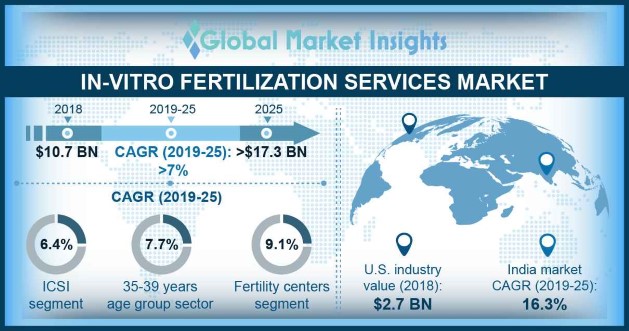Home > Healthcare > Medical Services > Inpatient and Outpatient Services > In-vitro Fertilization Services Market
In-vitro Fertilization Services Market Size
- Report ID: GMI3441
- Published Date: Jun 2019
- Report Format: PDF
In-vitro Fertilization Services Market Size
In-vitro Fertilization Services Market size was valued at USD 10.7 billion in 2018 and is expected to witness more than 7% CAGR from 2019 to 2025.
Increasing prevalence of infertility will significantly contribute to in-vitro fertilization services market growth in forthcoming years. According to National Center for Biotechnology Information, approximately 8-12% of couples face issues such as infertility and impaired fecundity. Factors such as changing lifestyles, late childbearing, and heredity are the major risk factors that lead to infertility. Thus, rising risk factors coupled with increasing acceptance of IVF procedures will lead to market expansion over the coming years.
Growing awareness about assisted reproductive technology will highly impact utilization of IVF services over the upcoming years. For instance, the Asia Pacific Initiative on Reproduction (ASPIRE), a group of scientists and clinicians, engaged in fertility management and ART. ASPIRE aims at promoting awareness about infertility and IVF procedures and improving infertility-related services in Asia-Pacific region. In addition, understanding and knowledge about the success rate of IVF procedures will further propel market growth.
| Report Attribute | Details |
|---|---|
| Base Year: | 2018 |
| In-vitro Fertilization Services Market Size in 2018: | 10.7 Billion (USD) |
| Forecast Period: | 2019 to 2025 |
| Forecast Period 2019 to 2025 CAGR: | 7% |
| 2025 Value Projection: | 17.3 Billion (USD) |
| Historical Data for: | 2014 to 2018 |
| No. of Pages: | 140 |
| Tables, Charts & Figures: | 200 |
| Segments covered: | Procedure, Age Group, End-use and Region |
| Growth Drivers: |
|
| Pitfalls & Challenges: |
|
However, social barriers and lack of advanced infrastructure in emerging economies will hinder market growth. Women belonging to lower-income countries as well as having lower annual income face affordability issues due to lack of insurance policies. Additionally, irregular reimbursement coverage and unorganized regulatory scenario are further hampering market growth.

